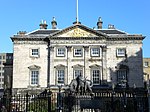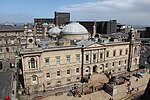York Place, Edinburgh
AC with 0 elementsNew Town, EdinburghStreets in Edinburgh

York Place is a street in central Edinburgh of almost exclusively 18th century buildings, linking Queen Street to Broughton Street and Leith Walk. The street's architecture remains almost completely intact but it is one of the busiest streets in the city centre being part of the main east-west route for traffic together with the Edinburgh Trams line and several bus services.
Excerpt from the Wikipedia article York Place, Edinburgh (License: CC BY-SA 3.0, Authors, Images).York Place, Edinburgh
York Place, City of Edinburgh New Town/Broughton
Geographical coordinates (GPS) Address Nearby Places Show on map
Geographical coordinates (GPS)
| Latitude | Longitude |
|---|---|
| N 55.95623 ° | E -3.19044 ° |
Address
York Place 27
EH1 3HP City of Edinburgh, New Town/Broughton
Scotland, United Kingdom
Open on Google Maps









